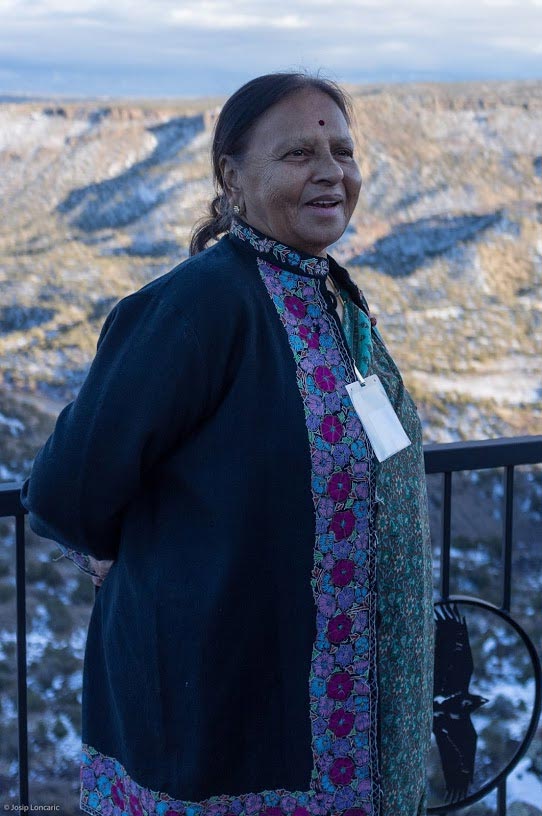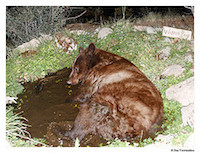
Selvi Viswanathan is a friendly fixture at PEEC. Not only does she volunteer every week as a docent at the center and serve on the Board of Directors, but she also meticulously tends to the colorful and serene butterfly garden outside of the center. Selvi is always happy to share her vast knowledge of gardening and our local wildlife, among other topics, and she is very passionate about making Los Alamos a certified Community Wildlife Habitat. PEEC sat down with Selvi to learn more about her, and how she gets those amazing wildlife shots with her critter cam!
PEEC: How did you become involved with PEEC?
S.V.: I used to work at Mary Deal Realty from 1984-1995. Then my husband retired, and I left realty. In 2004, I wanted to do something different. I saw an article about PEEC in the newspaper; I had never heard about it before. The article was about a study of bluebirds and a related upcoming program, and Becky Shankland was the listed contact. I knew Becky by name, because she was my son’s English teacher, so I contacted her. Becky suggested I come to the program at PEEC. That was 2005, the year that PEEC moved into the current building. When I came to the nature center, Becky introduced me to Chick Keller, Michele Altherr and Terry Foxx. I had heard about them but had never met them before. I met Dorothy Hoard too, and I was so excited because I had read her books. So, I became a PEEC member and started volunteering. Eventually I became a board member, too.
PEEC: You have a beautiful, natural yard, and it’s probably among the best-known in Los Alamos. How did you become interested in gardening and landscaping?
S.V.: Between 1995 and 2005, I spent a lot of time working on my yard. My son Hari was a big help when he would come home during the summers to work at the Lab. I always wanted a water feature, so he built three ponds in my yard. I saw something about the certification for the National Wildlife Federation (NWF), so I decided to apply. The NWF had contacted the Monitor to say my yard was the first one in Los Alamos to be certified, so the Monitor came to interview me for an article. The Master Gardeners saw the article, and they wanted to include my house in their tour in 1996. They did a very nice job, and that encouraged me to do more with my yard.
PEEC: Tell us about your gardens.
S.V.: I started out creating a memorial butterfly garden for my mother, and the National Butterfly Association (NBA) published it. Through the local Los Alamos Garden Club, I applied for an award from the New Mexico Garden Club for my butterfly garden and again the following year for my bird garden. Both years my gardens won first place. My new endeavor is a sensory garden. It hones the five senses – sight, sound, touch, taste and smell. I thought it would be good for my grandson, who is going to start kindergarten in the fall.
PEEC: Is there any crossover between your gardening and your work at PEEC?
S.V.: Definitely. When I came to PEEC, I told them my yard was certified, and that gave Michele Altherr the idea to have a tour of the certified yards in Los Alamos. She’s always been very supportive. In fact, everyone at PEEC has been so supportive of my interests, including gardening. From the Board of Directors to other volunteers to the staff – everyone is outstanding and really great to work with. I want to add, also, that my family has been so supportive of me – my husband Nathan, my son Hari, and my daughter-in-law Gowri. They encourage me to pursue these interests, and they volunteer at PEEC, too. Hari will be one of the panel members on an upcoming forum at PEEC [see below], and Gowri has participated in the Earth Day activities for several years with a Save the Tigers booth.
PEEC: We know you are also very interested in bird watching and photographing the wildlife in your yard. How did you get interested in that?
S.V.: When I first got married, I moved to New York City. I used to visit the Museum of Natural History, and I was always intrigued by the bird exhibits. We bought a house in the suburbs, with nice neighbors. One day the neighbor across the way, Mrs. White, told me there was a cardinal nesting in my yard. I actually bought a birdhouse and put seed in it – in those days, I didn’t know the difference between a birdhouse and a bird feeder [laughs]. Then my son Hari was born, and when he was 5 years old, we moved to New Mexico and started bird watching together. The natural landscaping we chose instead of a lawn attracted many bluebirds. When Hari was in about 4th grade, he did a science project to raise bluebirds. Our current house sits right in between two canyons, so again we chose to do natural landscaping. I have been amazed that I’ve been able to see about 100 species in my backyard!
PEEC: You are always sending us wonderful photos from your critter cam. Tell us how you get such great shots!
S.V.: I learned about the critter cam from PEEC and since then, I’ve always wanted to put one up. About two years ago we bought our own, and now the first thing Hari does when he comes to our house is to get the camera and download the photos. I’ve found that the neighbors are really in favor of knowing what wildlife is in our neighborhood and protecting them. I have to admit, the mountain lion was a shock to me – it was right in our backyard, just steps from our house! I’ve never actually seen one in person, just on the photos from the critter cam.

PEEC: Where did the name Warbler Pond come from?
S.V.: A lot of the warblers in this area only come to the pond not the feeders, so that’s why we named it Warbler Pond. Mostly we see them bathing in the pond. May and September are the best months to see the warblers and other colorful birds. Lately I’ve been watching ravens nesting across the canyon. The mother raven brings meat and dips it in the pond to soften it for her young. It’s fascinating to watch.
PEEC: Which part of India are you from?
S.V.: I’m from south India, but I grew up in east India until I was 29. In the south Indian tradition, before we go to school in the morning and before we eat breakfast, we take a small dish of rice with dal and ghee and feed it to the crows and sparrows. In my family I was the one to do this chore, because I was the only girl growing up. This was part of my daily routine from the age of 5. I guess it’s still a part of me – to this day, before breakfast I always fill the bird feeders and ponds. It’s a habit.
PEEC: What is your vision for Los Alamos and the new nature center?
S.V.: I will be really happy if we can certify Los Alamos as a Community Wildlife Habitat. It usually takes communities 5 years; we set our goal at 2 years, but I think we might be able to do it in one! Los Alamos is a natural fit – we don’t have to do much because the elements are already there. Many people worry they can’t provide water, especially in winter, but that’s not so. I have to thank Luisa Grant, who was the first one to suggest that Los Alamos could be the first community to be certified in the state of New Mexico. To become a certified Community Wildlife Habitat, there are certain criteria that must be met. For example, we need to have at least 100 certified homes, three schools and several public places. We are already well on our way to this goal. But beyond the certification, I would like to see our committee grow, so that we can branch out to cleaning up trails, holding events so the public can learn about providing habitats for our wildlife, and providing educational materials to community members and businesses. As for the new nature center, PEEC has grown slowly and beautifully over the last 14 years, and now it’s wonderful that we will have a new nature center. The new nature center is going to need more volunteers because we’ll be open longer hours, so I would encourage others to volunteer.
PEEC: How can people get involved with the initiative to certify Los Alamos as a Community Wildlife Habitat?
S.V.: I would encourage anyone who is interested to visit our webpage or to contact our committee. We currently have six members on our committee: Bob Walker, Hedy Dunn, Michele Altherr, Yvonne Keller, my son Hari Viswanathan, and myself. We actually get points toward our certification the more volunteers we have working on the effort. It’s not a huge time commitment, either. I would also suggest that they attend the Wildlife Habitat Forum at PEEC on June 11 at 7:00 p.m. It’s free, and we will talk about our local wildlife and how to get involved with the certified community effort. There is also a display about creating a Community Wildlife Habitat in the library lobby, which will be up until June 15. I would encourage people to stop by and have a look if they are interested.
